Presents, a Life with a Plan. My name is Karen Anastasia Placek, I am the author of this Google Blog. This is the story of my journey, a quest to understanding more than myself. The title of this blog, "The Secret of the Universe is Choice!; know decision" will be the next global slogan. Placed on T-shirts, Jackets, Sweatshirts, it really doesn't matter, 'cause a picture with my slogan is worth more than a thousand words, it's worth??.......Know Conversation!!!
Saturday, July 15, 2017
Just Love G-Suit!!
Hysterical strength
| This article or section appears to contradict itself. Please see the talk page for more information. (September 2016) |
Contents
[hide]Examples[edit]
- In 1982, in Lawrenceville, Georgia, Tony Cavallo was repairing a 1964 Chevrolet Impala automobile from underneath. The vehicle was propped up with jacks, but it fell. Cavallo's mother, Mrs. Angela Cavallo, lifted the car high enough and long enough for two neighbours to replace the jacks and pull Tony from beneath the car.[4]
- In 2006, Ivujivik, Quebec resident Lydia Angiyou saved several children by fighting a polar bear until a local hunter shot it.[5]
- In 2006, in Tucson, Arizona, Tom Boyle watched as a Chevrolet Camaro hit 18-year-old Kyle Holtrust. The car pinned Holtrust, still alive, underneath. Boyle lifted the Camaro off the teenager, while the driver of the car pulled the teen to safety.[4][6]
- In 2009, in Ottawa, Kansas, 1.70 m (5 ft 7 in), 84 kg (185 lb) Nick Harris lifted a Mercury sedan to help a 6-year-old girl pinned beneath.[7]
- In 2011, in Tampa, Florida, 1.91 m (6 ft 3 in), 134 kg (295 lb) University of South Florida college football player Danous Estenor lifted a 1,600 kg (3,500 lb) car off of a man who had been caught underneath. The man was a tow truck driver who had been pinned under the rear tire of a 1990 Cadillac Seville, which had lurched forward as he worked underneath it. The man suffered only minor injuries.[8]
- In 2012, in Glen Allen, Virginia, 22-year-old Lauren Kornacki rescued her father, Alec Kornacki, after the jack used to prop up his BMW slipped, pinning him under it. Lauren lifted the car, then performed CPR on her father and saved his life.[9]
- In 2013, in Oregon, teenage sisters Hanna (age 16) & Haylee (age 14) lifted a tractor to save their father pinned underneath.[10]
- In 2015, in St. John's, Newfoundland, Nick Williams lifted a four-wheel-drive vehicle to save a young boy pinned beneath its tire.[11]
- In 2015, in Vienna, Virginia, Charlotte Heffelmire was able to momentarily use incredible strength to free her father from a GMC pick-up truck.[12]
Research[edit]
nown
title = {Dictionary.com Unabridged},
month = {Jul},
day = {15},
year = {2017},
url = {http://www.dictionary.com/browse/nown},
}
G-suit
G-suit
© William Collins Sons & Co. Ltd. 1979, 1986 © HarperCollins
Publishers 1998, 2000, 2003, 2005, 2006, 2007, 2009, 2012
Cite This Source
title = {Collins English Dictionary - Complete & Unabridged 10th Edition},
month = {Jul},
day = {15},
year = {2017},
url = {http://www.dictionary.com/browse/g-suit},
}http://www.dictionary.com/browse/g-suit
https://www.google.com/search?q=the+1970+caught+on+the+News+of+a+mother+lifting+a+car+to+save+her+child&newwindow=1&safe=active&source=lnms&tbm=isch&sa=X&ved=0ahUKEwjc2sq8nYvVAhWHwVQKHQ8xA0IQ_AUIBigB&biw=1280&bih=678#newwindow=1&safe=active&tbm=isch&q=the+lady+who+founded+the+Fireman's+Fund+in+San+Francisco+and+show+the&imgdii=ppfF8B1Xr33QTM:&imgrc=PdbJuMzSmdSgaM:
Daught
 Daught was an old Scottish term for a wild, unnatural taste. Thus, something with such a flavour was described as having daught.
Daught was an old Scottish term for a wild, unnatural taste. Thus, something with such a flavour was described as having daught.Found on http://www.probertencyclopaedia.com/browse/AD.HTM
Sunday, July 12, 2015
Etymology[edit]
Trump in card games[edit]
Metaphorical uses[edit]
- "The CEO needs this report in one hour. That trumps anything you're currently working on."
- "He trumped my ace" for "I thought that I had a winning advantage, but he brought along something to defeat it."
- "At the hotel I ordered fresh orange juice with my breakfast ... the waiter brought out a trump excuse that there was not an orange in town."
Thursday, January 14, 2016
"... the highways of America are built chiefly of politics, whereas the proper material is crushed rock, or concrete"
Briscola
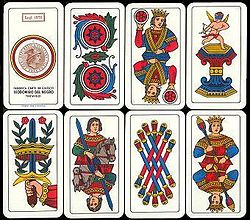 Italian playing cards from a deck of"Bergamasche" by Dal Negro | |
| Origin | Italy |
|---|---|
| Type | Trick taking |
| Players | 2-8 |
| Skills required | Tactics, Memory |
| Cards | 40 cards |
| Deck | Italian |
| Play | Counter-clockwise |
| Card rank (highest to lowest) | A 3 R C F 7 6 5 4 2 |
| Playing time | 25 min |
| Random chance | Medium |
| Related games | |
| Calabresella | |
Contents
[hide]The cards[edit]
| Cards, by rank | Point value |
|---|---|
| Ace (Asso) | 11 |
| Three (3) (Tre) | 10 |
| King (Re) | 4 |
| Knight (or Horse) (Cavallo) for Spanish type cards, Woman (or Queen) (Donna) for French (international) style cards. | 3 |
| Jack (Fante) | 2 |
Game play[edit]
- if any briscola (trump) has been played, the player who played the highest valued trump wins
- if no briscole (trumps) have been played, the player who played the highest card of the lead suit wins
"Conquista" or Black Hand[edit]
Signaling[edit]
- Ace - stretch the lips over the teeth or purse lips
- Three - distort the mouth to one side
- King - glance upwards or raise eyebrows
- Knight - shrug one shoulder
- Knave - show the tip of the tongue or lick your lips
- Threes or Aces outside of the Briscola suit - quickly open and close your mouth[3]
Variations[edit]
Briscola Chiamata[edit]
Scoring[edit]
- if the declarer and partner accumulate card points greater than or equal to the points that were declared after the bidding process
- the declarer earns two game points
- the partner earns one game point
- the other players each lose one game point
- if the declarer and partner accumulate fewer card points than declared
- the declarer loses two game points
- the partner loses one game point
- the other players each earn one game point
Variation[edit]
Briscola scoperta[edit]
Croatian variation[edit]
Briškula[edit]
Portuguese variations[edit]
Bisca[edit]
| Cards, by Rank | Point Value |
|---|---|
| Ace (ás) | 11 |
| Seven (7) (bisca or manilha) | 10 |
| King (rei) | 4 |
| Jack (valete) | 3 |
| Queen (dama) | 2 |
Sueca[edit]
Sueca Italiana[edit]
Presents, a Life with a Plan. My name is Karen Anastasia Placek, I am the author of this Google Blog. This is the story of my journey, a quest to understanding more than myself. The title of this blog, "The Secret of the Universe is Choice!; know decision" will be the next global slogan. Placed on T-shirts, Jackets, Sweatshirts, it really doesn't matter, 'cause a picture with my slogan is worth more than a thousand words, it's worth??.......Know Conversation!!!
Tuesday, June 30, 2015
The Ancient Fylfot
Contents
[hide]Etymology[edit]
- "In Great Britain the common name given to this Shield was Fylfot, said to have been derived from the Anglo-Saxon fower fot, meaning four-footed, or many-footed."[3]
- "The word [Fylfot] is Scandinavian and is compounded of Old Norse fiǫl-, equivalent to the Anglo-Saxon fela, German viel, "many", and fótr, "foot", the many-footed figure."[4] The Germanic root fele is cognate with English full, which has the sense of "many". Both fele and full are in turn related to the Greek poly-, all of which stem from the proto-Indo-European root *ple-. A fylfot is thus a "poly-foot", to wit, a "many-footed" sigil.
History[edit]
In heraldry[edit]
- Argent, a chevron between three fylfots gules--Leonard CHAMBERLAYNE, Yorkshire [so drawn in MS. Harleian, 1394, pt. 129, fol. 9=fol. 349 of MS.]
Modern use of the term[edit]
Saturday, April 2, 2016
To The Car Pro Show This Is (A) Type Air^In On The Pour^sshhh For The Fall^lo^EAN In^For^May^Shin???
type a.) https://en.wikipedia.org/wiki/High_endothelial_venules
Hybrid electric vehicle

Contents
[hide]Classification[edit]
Types of powertrain[edit]
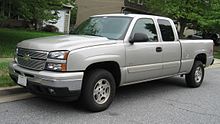

- In parallel hybrids, the ICE and the electric motor are both connected to the mechanical transmission and can simultaneously transmit power to drive the wheels, usually through a conventional transmission. Honda's Integrated Motor Assist (IMA) system as found in theInsight, Civic, Accord, as well as the GM Belted Alternator/Starter (BAS Hybrid) system found in the Chevrolet Malibu hybrids are examples of production parallel hybrids.[24] The internal combustion engine of many parallel hybrids can also act as a generator for supplemental recharging. Currently, commercialized parallel hybrids use a full size combustion engine with a single, small (<20 and="" are="" as="" battery="" be="" class="reference" comparable="" conditions="" contribute="" designed="" during="" efficient="" electric="" engine="" especially="" from="" hybrids="" id="cite_ref-UCSHbrid_24-1" is="" kw="" launch.="" main="" more="" motive="" motor="" nbsp="" non-hybrid="" not="" of="" pack="" parallel="" permitted="" power="" small="" sole="" source="" stop-and-go="" style="font-size: 11.2px; line-height: 1; unicode-bidi: isolate; white-space: nowrap;" sup="" supplement="" than="" the="" to="" urban="" vehicles="" where="">[24]
Types by degree of hybridization[edit]
- Full hybrid, sometimes also called a strong hybrid, is a vehicle that can run on just the engine, just the batteries, or a combination of both.[26] Ford's hybrid system, Toyota's Hybrid Synergy Drive and General Motors/Chrysler's Two-Mode Hybrid technologies are full hybrid systems.[27] The Toyota Prius, Ford Escape Hybrid, and Ford Fusion Hybrid are examples of full hybrids, as these cars can be moved forward on battery power alone. A large, high-capacity battery pack is needed for battery-only operation. These vehicles have a split power path allowing greater flexibility in the drivetrain by interconverting mechanical and electrical power, at some cost in complexity.
- Mild hybrid, is a vehicle that cannot be driven solely on its electric motor, because the electric motor does not have enough power to propel the vehicle on its own.[26][27] Mild hybrids only include some of the features found in hybrid technology, and usually achieve limited fuel consumption savings, up to 15 percent in urban driving and 8 to 10 percent overall cycle.[26][27] A mild hybrid is essentially a conventional vehicle with oversize starter motor, allowing the engine to be turned off whenever the car is coasting, braking, or stopped, yet restart quickly and cleanly. The motor is often mounted between the engine and transmission, taking the place of the torque converter, and is used to supply additional propulsion energy when accelerating. Accessories can continue to run on electrical power while the gasoline engine is off, and as in other hybrid designs, the motor is used for regenerative braking to recapture energy. As compared to full hybrids, mild hybrids have smaller batteries and a smaller, weaker motor/generator, which allows manufacturers to reduce cost and weight.[27]
- Honda's early hybrids including the first generation Insight used this design,[27] leveraging their reputation for design of small, efficient gasoline engines; their system is dubbed Integrated Motor Assist (IMA). Starting with the 2006 Civic Hybrid, the IMA system now can propel the vehicle solely on electric power during medium speed cruising. Another example is the 2005-2007 Chevrolet Silverado Hybrid, a full-size pickup truck.[27] Chevrolet was able to get a 10% improvement on the Silverado's fuel efficiency by shutting down and restarting the engine on demand and using regenerative braking. General Motors has also used its mild BAS Hybrid technology in other models such as the Saturn Vue Green Line, the Saturn Aura Greenline and the Mailbu Hybrid.[27]
Plug-in hybrids (PHEVs)[edit]

History[edit]
Early days[edit]
Predecessors of current technology[edit]
Modern hybrids[edit]
Latest developments[edit]
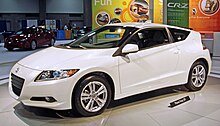
- 2009–2010
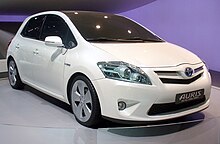
- 2011–2015

Sales and rankings[edit]

| Country | Number of registered hybrids by year | ||||||||
|---|---|---|---|---|---|---|---|---|---|
| 2014 | 2013 | 2012 | 2011 | 2010 | 2009[129] | 2008[130] | 2007[131] | ||
| Over 1 million[18] | 679,100(1)[132] | 678,000(1)[133] | 316,300(1)[133] | 392,200(1)[133] | 334,000[134] | 94,259 | 69,015 | ||
| 452,152[14] | 495,771[14] | 434,498[12] | 268,752[135] | 274,210[136] | 290,271[136] | 312,386[136] | 352,274[136] | ||
| 42,813[137] | 46,785[138] | 27,730[139] | 13,340[140] | 9,443[141] | 9,399[142] | 9,137[142] | 7,268[143] | ||
| 37,215[144] | 29,129[144] | 24,900[145] | 23,391[146] | 22,127[147] | 14,645[148] | 15,385[148] | 15,971[148] | ||
| 27,435[149] | 26,348[150] | 21,438[151] | 12,622[152] | 10,661[153] | 8,374[153] | 6,464[153] | 7,591[153] | ||
| 10,341[154] | 18,356[155] | 19,519[156][157] | 14,874[158] | 16,111[159] | 16,122[160] | 11,837[160] | 3,013[160] | ||
| Not available | ~15,000[161] | 14,595(1)[162] | Not available | 16,167(1) | 19,963[163] | 14,828 | |||
| World | Over 1.57 million | Over 1.31 million | Over 1.22 million | - | - | 740,000[164] | 511,758 | 500,405 | |
| Notes: (1) Partial sales, includes only Toyota/Lexus sales.[133] (2) Since 2011 French registrations include plug-in hybrids | |||||||||
Japanese market[edit]

U.S. market[edit]
European market[edit]
- UK
- France
- The Netherlands
- Germany
- Spain
Technology[edit]
Engines and fuel sources[edit]
Fossil fuels[edit]
- Gasoline
- Diesel
- Liquefied petroleum gas
- Hydrogen
Biofuels[edit]

Electric machines[edit]
Design considerations[edit]
Conversion kits[edit]
Environmental impact[edit]
Fuel consumption[edit]
- Reducing wasted energy during idle/low output, generally by turning the ICE off
- Recapturing waste energy (i.e. regenerative braking)
- Reducing the size and power of the ICE, and hence inefficiencies from under-utilization, by using the added power from the electric motor to compensate for the loss in peak power output from the smaller ICE.
Noise[edit]
Pollution[edit]
Top ten EPA-rated hybrids[edit]
among EPA's top ten 2013/16 model year most fuel efficient hybrid models available in the U.S. market[246][247]
| Vehicle | Year model | EPA Combined mileage (mpg) | EPA City (mpg) | EPA Highway (mpg) | Annual fuel cost (1) (USD) | Tailpipe emissions (grams per mile CO2) | EPA Air Pollution Score(2) | Annual Petroleum Use (barrel) |
|---|---|---|---|---|---|---|---|---|
| Toyota Prius Eco | 2016 | 56 | 58 | 53 | US$550 | 158 | NA | 5.9 |
| Toyota Prius (4th gen) | 2016 | 52 | 54 | 50 | US$600 | 170 | NA | 6.3 |
| Toyota Prius c | 2013/16 | 50 | 53 | 46 | US$600 | 178 | 7/8* | 6.6 |
| Toyota Prius (3rd gen) | 2013/15 | 50 | 51 | 48 | US$600 | 179 | 7/9* | 6.6 |
| Honda Accord (2nd gen) | 2014/15 | 47 | 50 | 45 | US$650 | 188 | 7/8* | 7.0 |
| Honda Civic Hybrid (3rd gen) | 2014/15 | 45 | 44 | 47 | US$700 | 196 | 7/9* | 7.3 |
| Volkswagen Jetta Hybrid | 2014/15 | 45 | 42 | 48 | US$850 | 200 | 7/9* | 7.3 |
| 2016 | 44 | 42 | 48 | 7.5 | ||||
| Ford Fusion (2nd gen) | 2013/16 | 42 | 44 | 41 | US$750 | 211 | 7/9* | 7.8 |
| Toyota Prius v | 2013/16 | 42 | 44 | 40 | US$750 | 211 | 7/8* | 7.8 |
| Lexus CT 200h | 2013/16 | 42 | 43 | 40 | US$750 | 212 | 7/8* | 7.8 |
| Source: U.S. Department of Energy and U.S. Environmental Protection Agency[246] Notes: (1) Estimates assumes 15,000 miles (24,000 km) per year (45% highway, 55% city) using average fuel price of US$2.04/gallon for regular gasoline and US$2.51/gallon for premium gasoline (national average as of 24 December 2015). (2) All states except California and Northeastern states, * otherwise.[246] | ||||||||
Vehicle types[edit]
Motorcycles[edit]
Automobiles and light trucks[edit]
High-performance cars[edit]
Formula 1[edit]

Taxis[edit]
Buses[edit]
Trucks[edit]
- Big mining machines like the Liebherr T 282B dump truck or Keaton Vandersteen LeTourneau L-2350 wheel loader are powered that way. Also there was several models of BelAZ (7530 and 7560 series) in USSR (now in Belarus) since the middle of 1970th.[262]
- NASA's huge Crawler-Transporters are diesel-electric.
- Mitsubishi Fuso Canter Eco Hybrid is a diesel-electric commercial truck.
- Azure Dynamics Balance Hybrid Electric is a gasoline-hybrid electric medium dutry truck based on the Ford E-450 chassis.
- Hino Motors (a Toyota subsidiary) has the world's first production hybrid electric truck in Australia (110 kW or 150 hp diesel engine plus a 23 kW or 31 hp electric motor).[263]
Military vehicles[edit]
Locomotives[edit]
Marine and other aquatic[edit]
Aircraft[edit]
Hybrid premium and showroom cost parity[edit]
| Vehicle type | Fuel used |
|---|---|
| All-petroleum vehicle | Most use of petroleum |
| Regular hybrid electric vehicle | Less use of petroleum, but non-pluginable |
| Plug-in hybrid vehicle | Residual use of petroleum. More use of electricity |
| All-electric vehicle | Most use of electricity |
Raw materials shortage[edit]
| This section is outdated. Please update this article to reflect recent events or newly available information. (August 2013) |
Legislation and incentives[edit]
Canada[edit]
Israel[edit]
Japan[edit]
Jordan[edit]
Malaysia[edit]
Netherlands[edit]
New Zealand[edit]
Republic of Ireland[edit]
Sweden[edit]
United Kingdom[edit]
United States[edit]
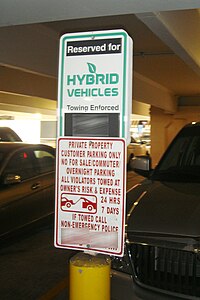
Federal[edit]
States and local[edit]
- Certain states (e.g., New York, California, Virginia, and Florida) allow singly occupied HEVs to enter the HOV lanes on the highway.Initially, the Federal Highway Administration ruled that this was a violation of federal statute[295]until August 10, 2005, when George W. Bush signed the Transportation Equity Act of 2005 into law. In California, a total of 85,250 owners of the three eligible hybrid models benefited from free access to HOV lanes from 2004 to mid-2011.[296] This incentive expired on July 1, 2011, and now hybrids are required to comply the minimum passenger requirements to use the HOV lanes.[297]
 California's clean air bumper sticker used to allow HEVs to access HOV lanes. Shown a RechargeIT's plug-inconverted Prius (left) and a conventional Toyota Prius (right).
California's clean air bumper sticker used to allow HEVs to access HOV lanes. Shown a RechargeIT's plug-inconverted Prius (left) and a conventional Toyota Prius (right). - Some states, e.g. California, exempt hybrid electric cars from the biennial smog inspection, which costs over $50 (as of 2004).
- The city of San Jose, California issued a free parking tag until 2007 when it became issued for a fee annually for hybrid electric cars that were purchased at a San Jose dealership. The qualified owners do not have to pay for parking in any city garage or road side parking meters.
- The city of Los Angeles, California offers free parking to all HEVs which started on 1 October 2004. The experiment is an extension to an existing offer of free parking for all pure electrical vehicles.
- In October 2005, the city of Baltimore, Maryland, started to offer discount on monthly parking in the city parking lots, and is considering free meter parking for HEVs. On 3 November 2005, the Boston Globe reports that the city council of Boston is considering the same treatment for hybrid electric cars.
- Annual vehicle registration fees in the District of Columbia are half ($36) that paid for conventional vehicles ($72).
Presents, a Life with a Plan. My name is Karen Anastasia Placek, I am the author of this Google Blog. This is the story of my journey, a quest to understanding more than myself. The title of this blog, "The Secret of the Universe is Choice!; know decision" will be the next global slogan. Placed on T-shirts, Jackets, Sweatshirts, it really doesn't matter, 'cause a picture with my slogan is worth more than a thousand words, it's worth??.......Know Conversation!!!
Wednesday, February 17, 2016
Do You Believe That This Is The Home Stretch?? Just Know This Is Not A Game Of Checkers On Chess. This Is A Breathing Method To Know That Life Is A Dust^Stir To The Shelves Of A Library Men^Shin!!
Turing machine
A Turing machine is an abstract machine[1] that manipulates symbols on a strip of tape according to a table of rules; to be more exact, it is a mathematical model that defines such a device.[2] Despite the model's simplicity, given any computer algorithm, a Turing machine can be constructed that is capable of simulating that algorithm's logic.[3]
Contents
[hide]- 1Overview
- 2Informal description
- 3Formal definition
- 4Additional details required to visualize or implement Turing machines
- 5Models equivalent to the Turing machine model
- 6Choice c-machines, Oracle o-machines
- 7Universal Turing machines
- 8Comparison with real machines
- 9History
- 9.1Historical background: computational machinery
- 9.2The Entscheidungsproblem (the "decision problem"): Hilbert's tenth question of 1900
- 9.3Alan Turing's a- (automatic-)machine
- 9.41937–1970: The "digital computer", the birth of "computer science"
- 9.51970–present: the Turing machine as a model of computation
- 10See also
- 11Notes
- 12References
- 13External links
Overview[edit]
Physical description[edit]
- ...an unlimited memory capacity obtained in the form of an infinite tape marked out into squares, on each of which a symbol could be printed. At any moment there is one symbol in the machine; it is called the scanned symbol. The machine can alter the scanned symbol, and its behavior is in part determined by that symbol, but the symbols on the tape elsewhere do not affect the behavior of the machine. However, the tape can be moved back and forth through the machine, this being one of the elementary operations of the machine. Any symbol on the tape may therefore eventually have an innings.[17] (Turing 1948, p. 3[18])
Informal description[edit]

- A tape divided into cells, one next to the other. Each cell contains a symbol from some finite alphabet. The alphabet contains a special blank symbol (here written as '0') and one or more other symbols. The tape is assumed to be arbitrarily extendable to the left and to the right, i.e., the Turing machine is always supplied with as much tape as it needs for its computation. Cells that have not been written before are assumed to be filled with the blank symbol. In some models the tape has a left end marked with a special symbol; the tape extends or is indefinitely extensible to the right.
- A head that can read and write symbols on the tape and move the tape left and right one (and only one) cell at a time. In some models the head moves and the tape is stationary.
- A state register that stores the state of the Turing machine, one of finitely many. Among these is the special start state with which the state register is initialized. These states, writes Turing, replace the "state of mind" a person performing computations would ordinarily be in.
- A finite table[19] of instructions[20] that, given the state(qi) the machine is currently in and the symbol(aj) it is reading on the tape (symbol currently under the head), tells the machine to do the following in sequence (for the 5-tuple models):
- Either erase or write a symbol (replacing aj with aj1), and then
- Move the head (which is described by dk and can have values: 'L' for one step left or 'R' for one step right or 'N' for staying in the same place), and then
- Assume the same or a new state as prescribed (go to state qi1).
Formal definition[edit]
 where
where is a finite, non-empty set of states
is a finite, non-empty set of states is a finite, non-empty set of tape alphabet symbols
is a finite, non-empty set of tape alphabet symbols is the blank symbol (the only symbol allowed to occur on the tape infinitely often at any step during the computation)
is the blank symbol (the only symbol allowed to occur on the tape infinitely often at any step during the computation) is the set of input symbols
is the set of input symbols is a partial function called the transition function, where L is left shift, R is right shift. (A relatively uncommon variant allows "no shift", say N, as a third element of the latter set.) If
is a partial function called the transition function, where L is left shift, R is right shift. (A relatively uncommon variant allows "no shift", say N, as a third element of the latter set.) If  is not defined on the current state and the current tape symbol, then the machine halts.[21]
is not defined on the current state and the current tape symbol, then the machine halts.[21] is the initial state
is the initial state is the set of final or accepting states. The initial tape contents is said to be accepted by
is the set of final or accepting states. The initial tape contents is said to be accepted by  if it eventually halts in a state from
if it eventually halts in a state from  .
.


 ("blank")
("blank")
 (the initial state)
(the initial state)
 see state-table below
see state-table below
 .
.| Tape symbol | Current state A | Current state B | Current state C | ||||||
|---|---|---|---|---|---|---|---|---|---|
| Write symbol | Move tape | Next state | Write symbol | Move tape | Next state | Write symbol | Move tape | Next state | |
| 0 | 1 | R | B | 1 | L | A | 1 | L | B |
| 1 | 1 | L | C | 1 | R | B | 1 | R | HALT |
Additional details required to visualize or implement Turing machines[edit]
- There will need to be many decisions on what the symbols actually look like, and a failproof way of reading and writing symbols indefinitely.
- The shift left and shift right operations may shift the tape head across the tape, but when actually building a Turing machine it is more practical to make the tape slide back and forth under the head instead.
- The tape can be finite, and automatically extended with blanks as needed (which is closest to the mathematical definition), but it is more common to think of it as stretching infinitely at both ends and being pre-filled with blanks except on the explicitly given finite fragment the tape head is on. (This is, of course, not implementable in practice.) The tape cannot be fixed in length, since that would not correspond to the given definition and would seriously limit the range of computations the machine can perform to those of a linear bounded automaton.
Alternative definitions[edit]
 to
to  , where N ("None" or "No-operation") would allow the machine to stay on the same tape cell instead of moving left or right, does not increase the machine's computational power.
, where N ("None" or "No-operation") would allow the machine to stay on the same tape cell instead of moving left or right, does not increase the machine's computational power.- (definition 1): (qi, Sj, Sk/E/N, L/R/N, qm)
- ( current state qi , symbol scanned Sj , print symbol Sk/erase E/none N , move_tape_one_square left L/right R/none N , new state qm )
- (definition 2): (qi, Sj, qm, Sk/E/N, L/R/N)
- ( current state qi , symbol scanned Sj , new state qm , print symbol Sk/erase E/none N , move_tape_one_square left L/right R/none N )
| Current state | Scanned symbol | Print symbol | Move tape | Final (i.e. next) state | 5-tuples | |
|---|---|---|---|---|---|---|
| A | 0 | 1 | R | B | (A, 0, 1, R, B) | |
| A | 1 | 1 | L | C | (A, 1, 1, L, C) | |
| B | 0 | 1 | L | A | (B, 0, 1, L, A) | |
| B | 1 | 1 | R | B | (B, 1, 1, R, B) | |
| C | 0 | 1 | L | B | (C, 0, 1, L, B) | |
| C | 1 | 1 | N | H | (C, 1, 1, N, H) |
| Current m-configuration (Turing state) | Tape symbol | Print-operation | Tape-motion | Final m-configuration (Turing state) | 5-tuple | 5-tuple comments | 4-tuple | |
|---|---|---|---|---|---|---|---|---|
| N1 | qi | Sj | Print(Sk) | Left L | qm | (qi, Sj, Sk, L, qm) | "blank" = S0, 1=S1, etc. | |
| N2 | qi | Sj | Print(Sk) | Right R | qm | (qi, Sj, Sk, R, qm) | "blank" = S0, 1=S1, etc. | |
| N3 | qi | Sj | Print(Sk) | None N | qm | (qi, Sj, Sk, N, qm) | "blank" = S0, 1=S1, etc. | (qi, Sj, Sk, qm) |
| 4 | qi | Sj | None N | Left L | qm | (qi, Sj, N, L, qm) | (qi, Sj, L, qm) | |
| 5 | qi | Sj | None N | Right R | qm | (qi, Sj, N, R, qm) | (qi, Sj, R, qm) | |
| 6 | qi | Sj | None N | None N | qm | (qi, Sj, N, N, qm) | Direct "jump" | (qi, Sj, N, qm) |
| 7 | qi | Sj | Erase | Left L | qm | (qi, Sj, E, L, qm) | ||
| 8 | qi | Sj | Erase | Right R | qm | (qi, Sj, E, R, qm) | ||
| 9 | qi | Sj | Erase | None N | qm | (qi, Sj, E, N, qm) | (qi, Sj, E, qm) |
The "state"[edit]
Thus the state of progress of the computation at any stage is completely determined by the note of instructions and the symbols on the tape. That is, the state of the system may be described by a single expression (sequence of symbols) consisting of the symbols on the tape followed by Δ (which we suppose not to appear elsewhere) and then by the note of instructions. This expression is called the 'state formula'.— Undecidable, p.139–140, emphasis added
- 1A1
Turing machine "state" diagrams[edit]
| Tape symbol | Current state A | Current state B | Current state C | ||||||
|---|---|---|---|---|---|---|---|---|---|
| Write symbol | Move tape | Next state | Write symbol | Move tape | Next state | Write symbol | Move tape | Next state | |
| 0 | P | R | B | P | L | A | P | L | B |
| 1 | P | L | C | P | R | B | P | R | HALT |

Models equivalent to the Turing machine model[edit]
Choice c-machines, Oracle o-machines[edit]
...whose motion is only partially determined by the configuration ... When such a machine reaches one of these ambiguous configurations, it cannot go on until some arbitrary choice has been made by an external operator. This would be the case if we were using machines to deal with axiomatic systems.— Undecidable, p. 118
Universal Turing machines[edit]
It is possible to invent a single machine which can be used to compute any computable sequence. If this machine U is supplied with the tape on the beginning of which is written the string of quintuples separated by semicolons of some computing machine M, then U will compute the same sequence as M.
Turing's paper ... contains, in essence, the invention of the modern computer and some of the programming techniques that accompanied it.— Minsky (1967), p. 104
Comparison with real machines[edit]
- Anything a real computer can compute, a Turing machine can also compute. For example: "A Turing machine can simulate any type of subroutine found in programming languages, including recursive procedures and any of the known parameter-passing mechanisms" (Hopcroft and Ullman p. 157). A large enough FSA can also model any real computer, disregarding IO. Thus, a statement about the limitations of Turing machines will also apply to real computers.
- The difference lies only with the ability of a Turing machine to manipulate an unbounded amount of data. However, given a finite amount of time, a Turing machine (like a real machine) can only manipulate a finite amount of data.
- Like a Turing machine, a real machine can have its storage space enlarged as needed, by acquiring more disks or other storage media. If the supply of these runs short, the Turing machine may become less useful as a model. But the fact is that neither Turing machines nor real machines need astronomical amounts of storage space in order to perform useful computation. The processing time required is usually much more of a problem.
- Descriptions of real machine programs using simpler abstract models are often much more complex than descriptions using Turing machines. For example, a Turing machine describing an algorithm may have a few hundred states, while the equivalent deterministic finite automaton (DFA) on a given real machine has quadrillions. This makes the DFA representation infeasible to analyze.
- Turing machines describe algorithms independent of how much memory they use. There is a limit to the memory possessed by any current machine, but this limit can rise arbitrarily in time. Turing machines allow us to make statements about algorithms which will (theoretically) hold forever, regardless of advances in conventional computing machine architecture.
- Turing machines simplify the statement of algorithms. Algorithms running on Turing-equivalent abstract machines are usually more general than their counterparts running on real machines, because they have arbitrary-precision data types available and never have to deal with unexpected conditions (including, but not limited to, running out of memory).
Limitations of Turing machines[edit]
Computational complexity theory[edit]
Concurrency[edit]
| This section does not cite any sources. Please help improve this section by adding citations to reliable sources. Unsourced material may be challenged and removed. (April 2015) |
History[edit]
Historical background: computational machinery[edit]
That the whole of development and operations of analysis are now capable of being executed by machinery.— (italics in Babbage as cited by Gandy, p. 54)
- The arithmetic functions +, −, × where − indicates "proper" subtraction x − y = 0 if y ≥ x
- Any sequence of operations is an operation
- Iteration of an operation (repeating n times an operation P)
- Conditional iteration (repeating n times an operation P conditional on the "success" of test T)
- Conditional transfer (i.e. conditional "goto").
... the emphasis is on programming a fixed iterable sequence of arithmetical operations. The fundamental importance of conditional iteration and conditional transfer for a general theory of calculating machines is not recognized ...— Gandy p. 55
The Entscheidungsproblem (the "decision problem"): Hilbert's tenth question of 1900[edit]
10. Determination of the solvability of a Diophantine equation. Given a Diophantine equation with any number of unknown quantities and with rational integral coefficients: To devise a process according to which it can be determined in a finite number of operations whether the equation is solvable in rational integers. The Entscheidungsproblem [decision problem for first-order logic] is solved when we know a procedure that allows for any given logical expression to decide by finitely many operations its validity or satisfiability ... The Entscheidungsproblem must be considered the main problem of mathematical logic.— quoted, with this translation and the original German, in Dershowitz and Gurevich, 2008
... most general form of the Entscheidungsproblem [is] as follows:
- A quite definite generally applicable prescription is required which will allow one to decide in a finite number of steps the truth or falsity of a given purely logical assertion ...
— Gandy p. 57, quoting Behmann
Behmann remarks that ... the general problem is equivalent to the problem of deciding which mathematical propositions are true.— ibid.
If one were able to solve the Entscheidungsproblem then one would have a "procedure for solving many (or even all) mathematical problems".— ibid., p. 92
But what Church had done was something rather different, and in a certain sense weaker. ... the Turing construction was more direct, and provided an argument from first principles, closing the gap in Church's demonstration.— Hodges p. 112
Alan Turing's a- (automatic-)machine[edit]
To the question 'what is a "mechanical" process?' Turing returned the characteristic answer 'Something that can be done by a machine' and he embarked on the highly congenial task of analysing the general notion of a computing machine.— Gandy, p. 74
I suppose, but do not know, that Turing, right from the start of his work, had as his goal a proof of the undecidability of the Entscheidungsproblem. He told me that the 'main idea' of the paper came to him when he was lying in Grantchester meadows in the summer of 1935. The 'main idea' might have either been his analysis of computation or his realization that there was a universal machine, and so a diagonal argument to prove unsolvability.— ibid., p. 76
It was stated above that 'a function is effectively calculable if its values can be found by some purely mechanical process'. We may take this statement literally, understanding by a purely mechanical process one which could be carried out by a machine. It is possible to give a mathematical description, in a certain normal form, of the structures of these machines. The development of these ideas leads to the author's definition of a computable function, and to an identification of computability with effective calculability. It is not difficult, though somewhat laborious, to prove that these three definitions [the 3rd is the λ-calculus] are equivalent.— Turing (1939) in The Undecidable, p. 160
[that] the Hilbert Entscheidungsproblem can have no solution ... I propose, therefore to show that there can be no general process for determining whether a given formula U of the functional calculus K is provable, i.e. that there can be no machine which, supplied with any one U of these formulae, will eventually say whether U is provable.— from Turing's paper as reprinted in The Undecidable, p. 145
1937–1970: The "digital computer", the birth of "computer science"[edit]
1970–present: the Turing machine as a model of computation[edit]
Depending on the objects one likes to manipulate in the computations (numbers like nonnegative integers or alphanumeric strings), two models have obtained a dominant position in machine-based complexity theory:
- the off-line multitape Turing machine..., which represents the standard model for string-oriented computation, and
- the random access machine (RAM) as introduced by Cook and Reckhow ..., which models the idealized Von Neumann style computer.
— van Emde Boas 1990:4
Only in the related area of analysis of algorithms this role is taken over by the RAM model.— van Emde Boas 1990:16










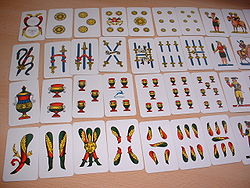






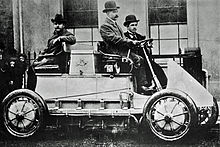










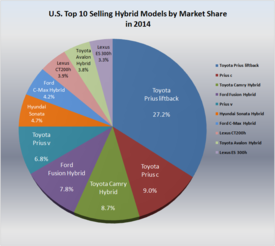












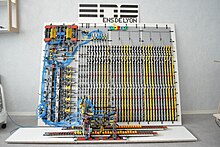
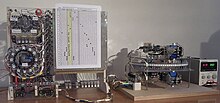









No comments:
Post a Comment